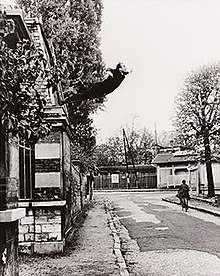
Back Performance (Kunst) ALS فن الأداء Arabic فن الاداء ARZ Performance AST Пэрформанс BE-X-OLD সম্পাদনী কলা Bengali/Bangla སྤྱོད་ལམ་སྒྱུ་རྩལ་ཐོག Tibetan Actuació artística Catalan Performanční umění Czech Performancekunst Danish

Performance art is an artwork or art exhibition created through actions executed by the artist or other participants. It may be witnessed live or through documentation, spontaneously developed or written, and is traditionally presented to a public in a fine art context in an interdisciplinary mode.[1] Also known as artistic action, it has been developed through the years as a genre of its own in which art is presented live. It had an important and fundamental role in 20th century avant-garde art.[2][3]
It involves five basic elements: time, space, body, presence of the artist, and the relation between the artist and the public. The actions, generally developed in art galleries and museums, can take place in any kind of setting or space, and during any time period.[4] Its goal is to generate a reaction, sometimes with the support of improvisation and a sense of aesthetics. The themes are commonly linked to life experiences of the artist themselves, the need for denunciation or social criticism and with a spirit of transformation.[5]
The term "performance art" and "performance" became widely used in the 1970s, even though the history of performance in visual arts dates back to futurist productions and cabarets from the 1910s.[6][1] Art critic and performance artist John Perreault credits Marjorie Strider with the invention of the term in 1969.[7] The main pioneers of performance art include Carolee Schneemann,[8] Marina Abramović,[9] Ana Mendieta,[10] Chris Burden,[11] Hermann Nitsch, Joseph Beuys, Nam June Paik, Tehching Hsieh, Yves Klein and Vito Acconci.[12] Some of the main exponents more recently are Tania Bruguera,[13] Abel Azcona,[14] Regina José Galindo,[15] Marta Minujín,[16] Melati Suryodarmo and Petr Pavlensky. The discipline is linked to the happenings and "events" of the Fluxus movement, Viennese Actionism, body art and conceptual art.[17]
- ^ a b "Performance Art". Tate Modern. Retrieved May 20, 2020.
- ^ "Performance Art Movement Overview". The Art Story. Retrieved May 12, 2020.
- ^ "Media & Performance". Moma Museo of Modern Art. Retrieved May 20, 2020.
- ^ Taylor y Fuentes, Diana y Macela (2011). "Estudios avanzados de performance" (PDF). Fondo de Cultura Económica. Archived from the original (PDF) on February 14, 2019. Retrieved February 8, 2019.
- ^ Franco Peplo, Fernando (2014). "El concepto de performance según Erving Goffman y Judith Butler" (PDF). Colección Documentos de trabajo. Editorial CEA. Año1. Número 3. Retrieved February 8, 2019.
- ^ "Etimología de performance". Etimologías de Chile. 2019. Retrieved May 20, 2020.
- ^ Perreault, John (1982). "Marjorie Strider: An Overview". In Van Wagner, Judith K. (ed.). Marjorie Strider: 10 Years, 1970-1980. Myers Fine Art Gallery. pp. 11–15.
- ^ Carreño Rio, Rodrigo. "Carolee Schneemann, Pionera y Referente". Le Miau Noir. Retrieved June 8, 2020.
- ^ "Marina Abramovic, pionera del performance". The Vault. April 8, 2018. Retrieved June 8, 2020.
- ^ "Ana Mendieta, la pionera cubana de la performance, está en Madrid". Diario de Cuba. February 14, 2020. Retrieved June 8, 2020.
- ^ Calvo, Irene (May 14, 2015). "Chris Burden, el body art y la performance de los 70: referentes actuales". Ah Magazine. Retrieved June 8, 2020.
- ^ Davis, Ben (April 28, 2017). "Vito Acconci, Transgressive Progenitor of Performance Art, Dies at 77". London Arte Week. Retrieved June 30, 2020.
- ^ "The Top 10 Living Artists of 2015". Artsy. 2015. Retrieved June 30, 2020.
- ^ "Abel Azcona, mejor artista de performance". Hoyu es arte. February 22, 2016. Retrieved June 30, 2020.
- ^ Toledo, Manuel (June 10, 2005). "Guatemalteca gana Leon de Oro". BBC Mundo. Retrieved November 28, 2022.
- ^ E. Cué, Carlos (February 17, 2017). "Marta Minujín "Desde los años sesenta no se ha hecho nada nuevo en arte"". El Pais. Retrieved June 30, 2020.
- ^ Fischer-Lichte, Erika. The Transformative Power of Performance: A New Aesthetics. New York and London 2008, Routledge. ISBN 978-0415458566.